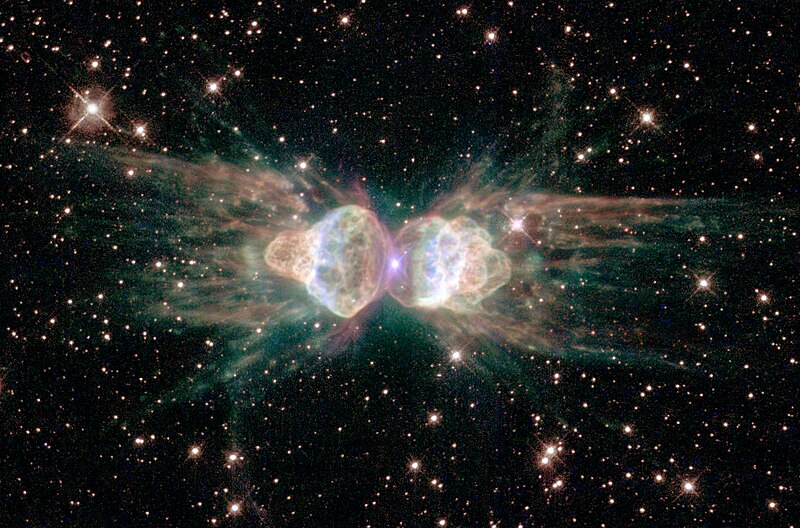Restr:Ant Nebula.jpg

Ment ar rakweled-mañ : 800 × 528 piksel. pizhderioù all : 320 × 211 piksel | 640 × 423 piksel | 1 072 × 708 piksel.
Restr orin (1 072 × 708 piksel, ment ar restr : 1,14 Mio, seurt MIME : image/jpeg)
Istor ar restr
Klikañ war un deiziad/eur da welet ar restr evel ma oa da neuze.
| Deiziad/Eur | Munud | Mentoù | Implijer | Notenn | |
|---|---|---|---|---|---|
| red | 1 C'hwe 2008 da 01:04 |  | 1 072 × 708 (1,14 Mio) | Papa November | Full res version from source |
| 1 C'hwe 2008 da 01:01 |  | 1 072 × 708 (148 Kio) | Papa November | Uploaded full resolution image from source | |
| 29 Gen 2008 da 14:30 |  | 600 × 362 (69 Kio) | Nk | {{Information |Description=The Ant planetary nebula (Menzel 3 or Mz 3). STScI-PRC2001-05 This NASA/ESA Hubble Space Telescope image reveals the ant's body as a pair of fiery lobes protruding from a dying, Sun-like star. Though approaching the violence o |
Implij ar restr
Implijout a ra ar bajenn da heul ar restr-mañ :
Implij hollek ar restr
Ober a ra ar wikioù da-heul gant ar restr-mañ :
- Implij war af.wikipedia.org
- Implij war an.wikipedia.org
- Implij war ar.wikipedia.org
- Implij war ar.wikiversity.org
- Implij war arz.wikipedia.org
- Implij war ast.wikipedia.org
- Implij war ba.wikipedia.org
- Implij war bg.wikipedia.org
- Implij war bjn.wikipedia.org
- Implij war bn.wikipedia.org
- Implij war ca.wikipedia.org
- Implij war cbk-zam.wikipedia.org
- Implij war ce.wikipedia.org
- Implij war cs.wikipedia.org
- Implij war de.wikipedia.org
- Implij war en.wikipedia.org
- Astronomy
- Norma (constellation)
- Talk:Outline of physical science
- Mz 3
- List of planetary nebulae
- Portal:Astronomy/Picture/May 2005
- Portal:Astronomy/Picture/August 2005
- Portal:Astronomy/Picture/17 May 2005
- Portal:Astronomy/Picture/10 August 2005
- Portal:Astronomy/Picture/Week 01 2006
- User:King Zebu
- User:Exoplanetaryscience/sandbox
- Implij war en.wikinews.org
- Implij war en.wikiversity.org
Gwelet muioc'h eus implij hollek ar restr-mañ.


